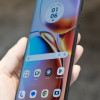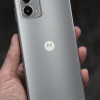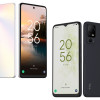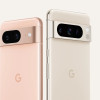State of the Industry
Mar 28, 2003, 7:00 PM by Rich Brome @rbrome.bsky.social
Wrap-Up Report from CTIA Wireless 2003 in New Orleans. An overview of all the major news from the show, put in perspective of what's going on throughout the industry.
Page 1
CTIA Wireless is the premiere event for the mobile phone industry in North America. Every year, companies gather to show off their latest and greatest mobile technology. The announcements generally reflect the current and emerging trends in the industry, so this wrap-up report is also an overview of those trends.
Most of the announcements weren't too surprising. With the rapid expansion of GSM networks in the U.S., I expected to see a lot more GSM phones than in previous years, and I wasn't disappointed. Push-To-Talk and camera phones are also two current hot topics, and both were well-represented at the show. But there were a few surprises, including several things conspicuously missing from the show.
GSM
GSM has been the dominant digital mobile phone standard globally for some time. But in the U.S., GSM didn't really take off until 2002, when AT&T Wireless and Cingular started deploying the standard nationwide. This massive shift in technology standards was reflected in the phones on display at CTIA. European GSM powerhouses such as Nokia, Sony Ericsson, and Siemens this year introduced their largest-ever portfolios of GSM phones designed specifically for North America.
One of the key issues in this shift is GSM 850. AT&T and Cingular both own large amounts of valuable 850 MHz spectrum, which they currently use for their aging TDMA and analog networks. In order to make the switch to GSM, they needed to use their 850 MHz spectrum with GSM - something which would require new GSM 850/1900 phones. The first GSM 850/1900 phones were announced at last year's CTIA show, and a slow trickle of additional models have been announced in the year since.
But at this year's CTIA, the floodgates really opened; a deluge of new GSM 850/1900 phones were announced. Siemens introduced the SL56 and M56 - GSM 850/1900 versions of the European SL55 and M55 announced the week before at CeBIT. Nokia announced the 3600 - a GSM 850/1900 version of the 3650, its current flagship Series 60 phone. And finally Panasonic was showing its just-announced X70, which will be available in a GSM 850/1800/1900 version for the Americas.
More exciting, however, are the new manufacturers joining the GSM fray. LG and Audiovox both chose CTIA to announce their first GSM phones for North America. LG announced the well-balanced 4050 and the affordable 4010, while Audiovox announced a series of GSM camera phones, which will start with the GS-200 and continue through the GS-400, with dual color displays and a megapixel camera.
One major disappointment, however, was the relative lack of quad-band GSM phones. In the past, a good "world phone" only needed to support three frequencies (tri-band). But with the advent of GSM 850, a world phone needs to be quad-band in order to get good coverage and reasonable roaming rates worldwide.
Only NEC and Motorola were showing quad-band phones that will be available before the end of 2003. The NEC 515 will most likely be the first. It was announced at last year's CTIA, and has been delayed several times. But it now appears to be very close to release. The Motorola V600 was announced in January, and it is planned for release in the 2nd half of the year. Both are very impressive phones, but two models is a very limited selection for such an important category of phones.
CDMA
CDMA is the other dominant digital mobile phone standard in the U.S. CTIA is the traditional venue for companies to announce their new CDMA portfolios, and this year was no exception. The new attention to GSM actually did very little to pull the spotlight away from CDMA. Two companies making notable new pushes into CDMA were Nokia and Motorola.
In 2001, Nokia appeared to have almost abandoned CDMA completely. In 2002, Nokia came out with a meager CDMA lineup using its new, revamped CDMA chipset. Nokia's 2003 models are a vast improvement, although a significant technology lag compared to the company's GSM models is still apparent. With the new announcements, Nokia for the first time has a full lineup of CDMA phones: the 2200 series covers the low end, the 3586i takes the middle spot, and the 6585 fills in the top end.
Motorola has traditionally kept its GSM and CDMA models in near-lockstep. Most CDMA models have had a near-identical GSM equivalent. In fact, in 2002 Motorola went as far as to drop model number variations altogether, releasing two "T720" models - one for CDMA and one for GSM, and did the same with the "v60i" and "C333". Thankfully, Motorola seems to have ended this confusing naming practice.
Motorola announced two all-new CDMA phones at CTIA - the E310 and V810. Neither has a GSM equivalent; both are visually and functionally distinct from any announced GSM models. The E310 is a gaming-centric phone, while the V810 is a svelte camera phone. Releasing unique models for CDMA is a big step for Motorola, and both phones look very promising; so far it looks like a step in the right direction.
The next big thing in the CDMA world is 1xEV-DO. Huge news came from Verizon Wireless when they announced at the show that they are preparing to launch commercial 1xEV-DO networks in two cities - San Diego and Washington, D.C. 1xEV-DO represents a giant leap forward in data speeds, with a peak of 2.4 mbps, and average speeds around 200-400 kbps (4-5 times faster than Verizon's current 1xRTT network).
At the press conference, Verizon Wireless executive vice president and chief technical officer Dick Lynch indicated that a nationwide launch was likely, and that Verizon plans to launch 1xEV-DO phones, in addition to the expected data cards. Thanks to the high data rates, 1xEV-DO phones can deliver a true "3G" experience, with full-motion video capability.
LG has taken a leadership role in 1xEV-DO handsets in Korea, the only country where such phones have been commercially launched so far. LG CEO John Koo demonstrated an impressive Korean LG 1xEV-DO phone during the CTIA keynote. But more importantly, LG representatives promised that LG intends to take a similar leadership role with 1xEV-DO phones here in the U.S.
The combination of LG's 1xEV-DO phones and Verizon's 1xEV-DO network may finally deliver the much-hyped "3G" mobile experience that has been promised for so long. And it might happen sooner than expected: possibly before the end of 2003.
Page 2
Camera Phones
A year ago, the camera phone phenomenon was still in its infancy. At CTIA 2002, only two models - both from Samsung - were announced that were even capable of connecting to an external camera. Outside of Japan, phones with built-in cameras were still unheard-of.
But in the 12 short months since then, the camera phone wave has moved so quickly that this year's show saw several manufacturers introducing their second-generation camera phone models.
One focus with second-generation models seems to be on making camera phones affordable. Sony Ericsson was certainly the first to recognize this trend with its ground-breaking T300 model, but the T300's camera was attachable. Attachable cameras seem to be on the way out. The Sanyo 8100, Audiovox 8900, and LG 5450 are all designed to bring integrated camera phones to the masses.
Another phone following this trend is the Nokia 3650 (and 3600) camera phone. It's actually one of the most powerful and feature-rich phones on the market, yet still quite affordable, to the point of being a bit of a paradox. I have to think that Nokia is using the 3650/3600 as a loss leader to build momentum for its Series 60 platform (making it essentially a pre-emptive strike against Microsoft's new Smartphone platform).
The 3650 is the first phone for the U.S. to support video messaging, (10-15 second clips). Video is undeniably the direction the technology is headed, but the 3650 is way ahead of the pack in bringing this kind of feature to market.
Push-To-Talk
The biggest buzzword of the show was - without a doubt - Push-To-Talk (PTT). PTT is the "walkie-talkie" feature that Nextel is famous for. Several companies are now competing to bring this feature to GSM and CDMA networks. The PTT hype was already at fever pitch well before the show started. Thankfully, some companies are finally delivering on their promises; some impressive systems were demonstrated live for the first time at CTIA.
The most impressive, in my opinion, was at the Comverse booth, where I tried a live demo of the system developed by Mobile Tornado (who recently partnered with Comverse). The Mobile Tornado system delivered the shortest latency (delay) at the show - a little over 1 second. It's not "instant" like Nextel's system, but it should be fast enough for most people. Trying to hold a conversation with a longer delay can be a tedious and frustrating experience. The Mobile Tornado system also had some impressive features - such as PTT call-waiting - that the other systems apparently lack.
The Expanding Low End
One interesting trend that was apparent at the show is that manufacturers are actively trying to extend the low end of their lineups even lower. Nokia introduced its 2200 series, LG introduced its 3100 and 4010 models, Kyocera announced its KE400 and K110 series, and Motorola announced its C230 at CeBIT the week before. Phones already on the market in this category include the Nokia 1260 and Siemens A56. The emphasis with these phones is price, and the goal is to allow carriers to sell phones to new groups of people, for whom owning a cell phone was previously a luxury they could not afford. Many of these phones are targeted at Latin America, but here in the U.S., these phones also make it easier and more profitable for carriers to offer "free" phones with contracts.
Page 3
Enterprise
A healthy portion of the announcements at CTIA were geared toward the enterprise (business) space. There was important news on all fronts: new networks, new devices, and new services.
The biggest news was probably Verizon's 1xEV-DO plans. As I mentioned earlier, this has exciting implications for phones. But, as with Verizon's 1xRTT rollout, the initial thrust with 1xEV-DO will be with data cards for laptops.
The speed boost provided by 1xEV-DO has very important implications for corporate users. Many companies require that their road warriers use VPN software, which adds an extra level of security. But VPN software often slows down the connection to the point of being almost unusable. With 1xEV-DO, wireless VPN connections should finally be a painless, perhaps even pleasant, experience.
But true nationwide 1xEV-DO is probably still about a year off, so something else is needed in the interim. One partial solution is Wi-Fi (802.11b), and there were several Wi-Fi announcements at CTIA. Verizon Wireless announced a partnership with Wayport to offer Verizon-branded Wi-Fi service in the third quarter.
Also, T-Mobile announced an extension of its relationship with Boingo, another national wi-fi hotspot company. T-Mobile's new initiative will focus on better integration between Boingo's wi-fi network and T-Mobile's GPRS network. That is definitely the direction everyone is headed. Most of the major carriers have announced plans to eventually offer seamless coverage across wi-fi and their 2.5G and 3G wireless networks. Right now, this kind of integration is cumbersome for the user and involves complicated billing. The race is on to simplify this; the only question is who will be first.
Moving on to devices for the enterprise, there weren't many surprises, but some important devices moved closer to actual release.
Sprint PCS announced that it will carry Samsung's SPH-i700 and SPH-i500 "MITs" convergence devices. The i700 runs Microsoft's Pocket PC Phone Edition OS, and sports an integrated swivel camera. The i500 is very small Palm OS smartphone. Sprint also announced that it will offer Hitachi's G1000 device. Like the Samsung i700, it runs Pocket PC Phone Edition and features a swivel camera. It is larger and heavier, but it is also the first Pocket PC with an integrated mini-keyboard.
Verizon Wireless also announced a Pocket PC and a Palm device. Verizon will finally offer the long-awaited Kyocera 7135 Palm OS phone, and will also carry the Samsung i700. Both will be available from Verizon in April.
With their large displays and robust software platforms, these devices are ideal for enterprise applications. Another platform that some had hoped would gain traction in the enterprise space is J2ME (Java). But with their small displays and slow processors, Java-enabled phones never really seemed like a viable platform for serious business applications.
That may be about to change. With its huge display and dedicated Java processor, the NEC 515 should encourage IT managers to re-examine the idea of deploying enterprise applications for the J2ME platform. While not the smallest phone out there, the 515 still delivers portability the i700 and G1000 can't begin to touch.
What Was Missing
Perhaps more interesting than what was at the show, was what wasn't at the show. There were several key technologies and companies that were conspicuously absent this year.
First and foremost was EDGE. EDGE is an upgrade to GSM/GPRS networks that doubles or triples data speeds. AT&T Wireless, Cingular, and T-Mobile have all announced plans for EDGE. In fact, it's the "next big thing" for all three companies - the next stepping stone on the path to "3G". AT&T is planning to launch EDGE nationwide in a just a few months, and the other companies plan to follow suit by the end of the year.
With EDGE seemingly right around the corner, the complete absence of new EDGE phones was a bit of a shocker. The Nokia 6200 and 6220, Motorola T725, and a Sony Ericsson PC card for laptops have already been announced. But at this point in the game, I really expected several new EDGE phones at CTIA.
I don't think EDGE is in any jeopardy as a technology; it's a compelling upgrade for carriers. But perhaps there are technological challenges that are causing a slow start for EDGE handsets. Hopefully this will change before the end of the year.
Another technology I expected to see represented in the new phones was GAIT. GAIT is a technology designed to ease the transition from TDMA to GSM - the transition Cingular and AT&T are smack-dab in the middle of right now. GAIT phones work on both types of networks, and include special technology that allows services to operate transparently regardless of which network is being used.
AT&T Wireless has enough spectrum that they can pretty much let people switch to GSM at their leisure. Cingular, however, is not so lucky. Due to spectrum constraints, they can't start moving their network to GSM in certain areas until a certain percentage of their users in that area have GAIT phones. Really cool new GAIT phones would seem like the ideal incentive to make this happen.
Therefore, I expected some nifty new GAIT phones at CTIA. But Nokia, Siemens, and Sony Ericsson (all manufacturers of existing GAIT or GAIT-like phones) all indicated that they don't have any immediate plans for new GAIT models, although they are open to the idea if carriers request it. LG was the only company that seemed to have specific GAIT plans.
It seems that the manufacturers are simply following the demands of the carriers. If Cingular isn't asking manufacturers for new GAIT models, I'm completely stumped as to why.
Another curious absence at the show was anything to do with iDEN - the standard used by Nextel. Motorola's iDEN group had zero presence, and no new iDEN models were announced. The timing seemed about right for Motorola's rumored "Falcon" line of iDEN phones, so this was a bit surprising. Since iDEN is a relatively unpopular standard as it is, and it has been a while since Motorola came out with any new models, I would think that Motorola would be anxious to remind everyone that iDEN is still a thriving standard. Apparently this is not the case.
It has been speculated that Nextel will eventually drop iDEN and switch to CDMA. If Nextel is planning to announce such a switch soon, that could spell the end of Motorola's iDEN group. This is one possible explanation for the deafening silence from the iDEN corner, but perhaps there is a less dramatic explanation.
Another conspicuous absence was Microsoft Windows Powered Smartphone. For a very large company that is supposedly trying to make a big push into the cell phone market, Microsoft's presence was surprisingly low-key. The timing seemed right for a new Smartphone model, or at least a carrier announcement, but there was nothing of the sort. There were a few HTC Tanager (SPVx) Smartphones on display at the Microsoft booth, but no one was really talking about them. The focus seemed to be on the Pocket PC Phone Edition devices.
Microsoft did hold a co-located conference for mobility developers, which started just at CTIA ended. But that also seemed very focused on the Pocket PC platform. For example, Bill Gates announced that Microsoft is giving away 25,000 Viewsonic Pocket PCs to qualified developers, while developers still must shell out several hundred dollars for a kit that includes a Smartphone.
Particularly curious was the absence of Samsung's i600 Smartphone. As the only big-name manufacturer signed on, Samsung is key to the platform. The i600 has been previewed at several past events, and at least one version is known to be intended for U.S. CDMA networks, making its absence at CTIA all the more suspicious.
Samsung also failed to show a Microsoft Smartphone at CeBIT the week before, leading some industry observers to speculate that Samsung's Smartphone program (and relationship with Microsoft) is on the rocks. Microsoft strenuously denies that this is the case, but it's still quite puzzling.
Speaking of Samsung, their only new phone announcements at CTIA were the A600 camera phone for Sprint PCS, and the hideous Matrix phone, also for Sprint. Especially given the dizzying array of new phones announced for Europe at CeBIT the week before, their relatively anemic presence at CTIA casts doubt on the company's commitment to the U.S. market.
So that's my take on this year's show. There was some good news, some unexpected surprises, but some major disappointments as well. Most of the new phone models are evolutionary, not revolutionary, but there can't be a revolution every year. It was still a good event, and it's clear that mobile users have a lot to look forward to over the next year.


 Hands On with the Motorola edge+ (2023)
Hands On with the Motorola edge+ (2023)
 Hands On with the 2023 moto g 5G & moto g stylus
Hands On with the 2023 moto g 5G & moto g stylus
 TCL Brings NXTPAPER Display Tech to Phones
TCL Brings NXTPAPER Display Tech to Phones
 Google Teases More of Pixel 8
Google Teases More of Pixel 8
 New York State Launches Mobile ID App
New York State Launches Mobile ID App







